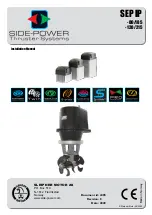
BDM-610000084 Rev B
Chapter 1: Introduction 15
Migrating to RTD’s Intel E3800 Series cpuModules
When migrating to RTD’s Intel E3800 Series cpuModules, there are several differences from some preceding RTD
cpuModule product families of which the customer should be aware.
Connector Pinout & Function Differences
The Intel E3800 Series cpuModules have several connector-related differences, which are summarized below.
Complete information about the connectors on the CML24BT can be found in Chapter 3,
Connecting the
cpuModule
.
New I/O Connectors
The CML24BT cpuModule introduces a new I/O connector that was not present on some previous RTD
cpuModules:
•
DisplayPort (CN19)
–
Provides video and audio output
–
Unlike legacy LVDS and flat panel connectors which needed to have their BIOS pre-configured
to a specific manufacturer’s flat panel parameters, the DisplayPort connector is compatible with
any display that has a DisplayPort interface.
Connector Differences
While some connectors on the CML24BT have identical pinouts as on previous cpuModule generations, the
features of the connector are sometimes different. Other connectors have entirely different pinouts than those
on previous cpuModule generations. Connectors with pinout and feature differences include:
•
Auxiliary Power Connector (CN3)
–
12 pins (unlike the 10-pin connector on RTD Montevina cpuModules)
–
+5V and +12V inputs (5V only auxiliary power connectors found on previous RTD
cpuModule generations)
•
While the RTD Intel E3800 Series CPU only re5 volts, +12V may optionallly be
connected to CN3 if it is required by any other device in the system.
–
The Auxilliary Power Connector excludes ATX power signaling. The ATX power signals are
provided on the PCIe/104 Type 2 and PCI-104 bus connectors.
•
Utility Port 2.0 (CN5)
–
Replaces the legacy Utility Port multi-function connector
–
Replaces the PS/2 Mouse and Keyboard connections with one USB 2.0 port
–
The pinout of the Utility Port 2.0 is
not
compatible with previous generations of RTD
cpuModules.
•
COM Ports (CN7 and CN8)
–
Connector
CN7
can be configured to output Serial POST codes out of the TXD pin when in
single RS-232 mode (unlike RTD Montevina cpuModules, where the DTR pin was configured for
serial POST code output on the second port of CN7 in dual-port mode). For more information,
refer to
Serial Power-On-Self-Test (POST) Code Output
on page 71.
–
Of all single and dual-port modes, only the single RS-232 pinout is compatible with previous
generations of RTD cpuModules.
–
Dual-mode COM port pinouts permit dual RS-232, dual RS-422, and dual RS-485 modes. Unlike
some previous generations of RTD cpuModules, a dual “combined” mode with RS-232 and
RS-422/458 is not supported.
Содержание CML24BT cpuModules
Страница 1: ...ISO9001 and AS9100 Certified www rtd com CML24BT cpuModules User s Manual BDM 610000084 Revision B...
Страница 3: ...www rtd com ISO9001 and AS9100 Certified CML24BT cpuModules...
Страница 5: ...BDM 610000084 Rev B v...
Страница 6: ...vi CML24BT cpuModule BDM 610000084 Rev B...
Страница 41: ...BDM 610000084 Rev B Chapter 3 Connecting the cpuModule 31...
Страница 66: ...56 CML24BT cpuModule BDM 610000084 Rev B...
Страница 86: ...72 CML24BT cpuModule BDM 610000084 Rev B...
Страница 92: ...78 CML24BT cpuModule BDM 610000084 Rev B Figure 11 CML24BTQ1910 Heatsink Edge near PCIe 104 Connector...
Страница 94: ...80 CML24BT cpuModule BDM 610000084 Rev B...
Страница 108: ...92 CML24BT cpuModule BDM 610000084 Rev B...
Страница 110: ...94 CML24BT cpuModule BDM 610000084 Rev B...
Страница 112: ...96 CML24BT cpuModule BDM 610000084 Rev B...
















































